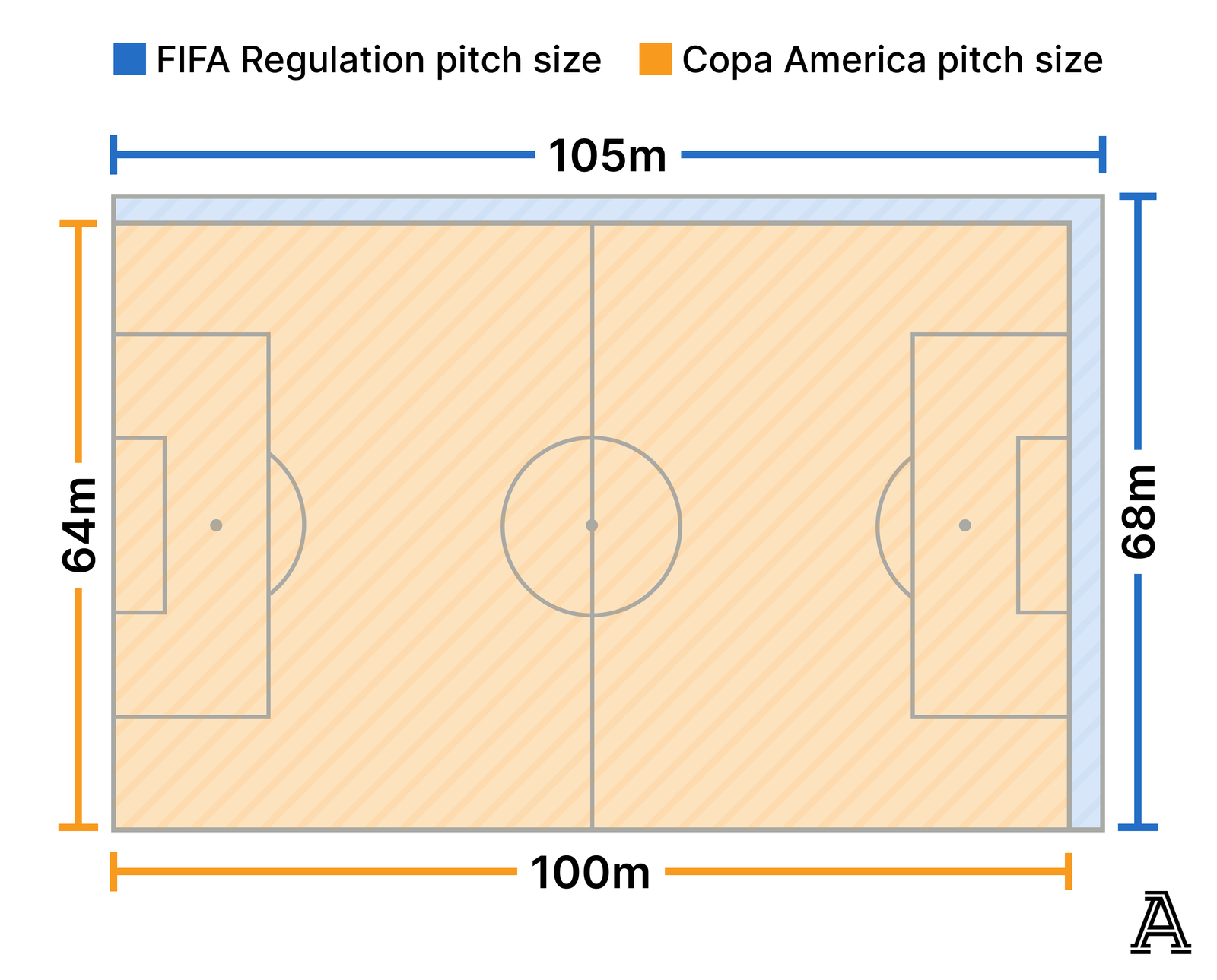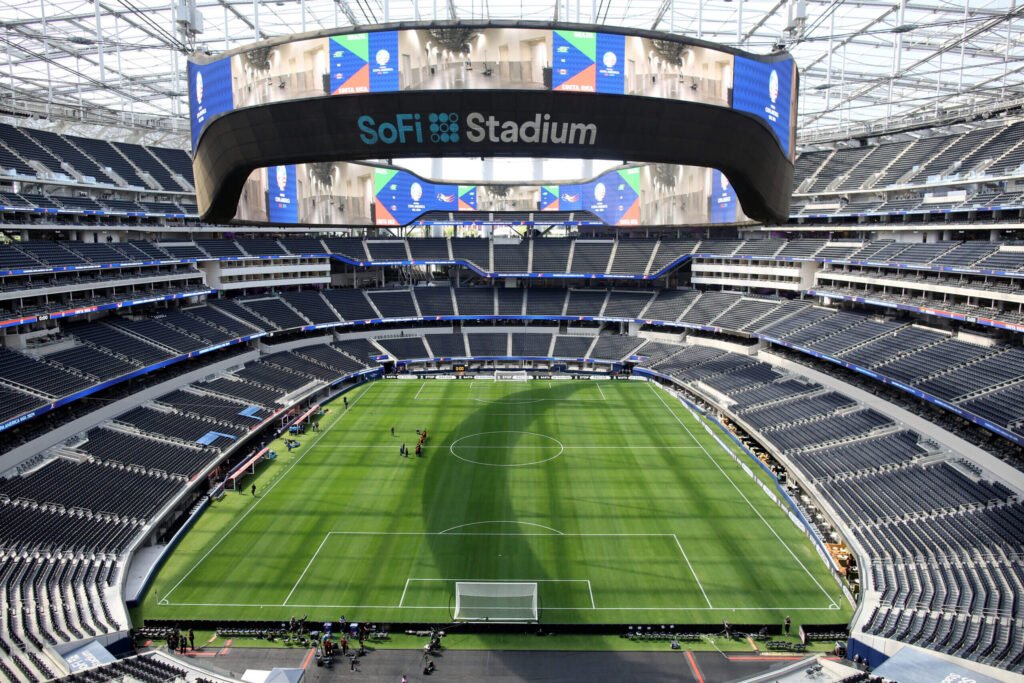Something doesn’t look quite right.
It feels as though there’s a lack of space and that players are on top of one another in wide areas in particular.
As your eyes dart around the field, you can’t help but notice how the edge of the penalty area and the touchline seem to be unusually close. That’s because they are unusually close.
The Copa America is being played on the smallest pitch size permitted for an international fixture: 100 metres long and 64 metres wide (109 by 70 yards).
Or, to put it another way, a prestigious tournament involving some of the biggest football nations in the world is taking place on pitches that are similar to the dimensions under-13 academy players regularly use in England to help them transition from 9-a-side to 11-a-side football for the first time: bringing in the sidelines and shortening the length to reduce the physical demands. The total amount of space lost is roughly the equivalent of the size of a penalty area.
That’s all well and good for children, but it’s not normal for senior international footballers.
“I would like to draw attention to the size of the pitches,” Dorival Junior, Brazil’s manager, said before Monday night’s goalless draw against Costa Rica. “It will mean that the games are going to be more closely contested. A team defending its own box will be able to go on the counter-attack and reach the attacking half much more quickly. That’s worth thinking about.
“We have been talking a lot about it in training — how it will make it easy to get forward swiftly, but also how it will be more difficult to find a way past a (deep) defence. The distance between where you regain possession and the opposition goal is a lot shorter than matches in our country.”
Danilo, Brazil’s captain, sounded like a man who had just had the rug — or maybe that should be the grass — pulled from under his feet after he inspected the playing surface at Los Angeles’ SoFi Stadium.
“I was pleasantly surprised by the quality of the pitch, which will allow us to play a technical match,” the Juventus full-back said. “But with these dimensions, expect combat, war, lots of physical challenges.”
Danilo (left) said the pitches would make games very physical (Mark Leech/Offside/Offside via Getty Images)
Brazil didn’t fail to beat Costa Rica because of the size of the pitch, but there’s no question that it was a factor in the game — something the Costa Rica coach Gustavo Alfaro acknowledged afterwards — and that it’s going to significantly impact this tournament. Even those who were victorious in their opening match accepted that reality.
“The measurements are extremely narrow,” Nestor Lorenzo, Colombia’s manager, said after their 2-1 victory over Paraguay on Monday. “One hundred (metres) by 63 (sic), right? What’s more, you see throw-ins reaching the six-yard box regularly — even me, without any strength, could get the ball there. Nearly every player out there is used to playing on a much wider pitch. Wider and longer, too. And that helps the team that presses, almost always.”
If you’re wondering why this has happened, the answer is fairly straightforward.
CONMEBOL, South American football’s governing body and the organisers of the tournament, wanted every pitch to be the same size, which makes total sense. One team does not get an advantage just by playing at a particular stadium. But that becomes a bit of a problem when NFL stadiums are used to host football matches (as is the case with 11 of the 14 Copa America venues); in particular, NFL stadiums where there is limited room to increase the playing area (for context, every NFL field is 110 metres long but only 49 metres wide).
The lack of wriggle room in places (corner kicks, shown below from the Peru–Chile game, can be an interesting experience for anyone trying to take an outswinger) has been most obvious at SoFi Stadium in California, MetLife Stadium in New Jersey, and AT&T Stadium in Dallas. But everyone else has had to fall in line with the limitations, even if that means shortening and narrowing a perfectly good-sized pitch – Children’s Mercy Park in Kansas, where the lines used for MLS games were clearly visible during Tuesday’s match between Peru and Canada, is a case in point.
In summary, it’s a one-size-fits-all approach at Copa America 2024 — and that size is small.
“All of the pitches feature natural grass (we converted the synthetic surfaces to natural grass at six stadiums) and every pitch is 100m x 64m,” a CONMEBOL spokesperson told The Athletic.
It will be a different story when the men’s World Cup comes to the U.S., Mexico and Canada in two years’ time. All the venues will have to comply with world governing body FIFA’s strict regulations around pitch size — a playing surface that is 105m x 68m (the same as the Premier League demands) and has a significant run-off area. At some stadiums, that means seats will need to be removed and major building work carried out. In fact, it’s already started at MetLife Stadium, at a cost of $16million (£12.7m at current rates).
“Early on in this process, we learned MetLife Stadium, like many other NFL stadiums, were built a little more like an oval, and the field for soccer, or (the) pitch, needs to be a little more rectangular,” Lauren Nathan-LaRusso, co-host city manager and general counsel of the New York New Jersey host committee, explained a fortnight ago. “So, in the corners, for our stadium, we did need to widen them. That work began this year and we’ve done one side of the stadium and we’ll do the next (side) next year.”
Problem solved for the World Cup, then. But what about now?

The long and short of it, if you excuse the pun, is that the coaches and players at Copa America need to get on with it and adapt.
The penalty area dimensions can’t change. Indeed, you don’t need to be a mathematician to work out that the area where, proportionately, the most amount of space has been lost is on the flanks (whether that realisation will make Vinicius Junior feel better or worse after his disappointing performance against Costa Rica is unclear).
“If we take a look at the (Costa Rica) marking, it was very fast and that’s normal because this is a smaller pitch, vertically and horizontally, and that affects the defence and makes the attack more difficult,” Dorival Junior said after Brazil’s opening game. “It (the pitch size) facilitates defending and difficult attacking, so double-marking happens easier — when Vini had the ball, he had two markers on him and a third one was approaching. Raphinha suffered the same.”
The general consensus is that defensive teams or, as Lorenzo flagged up, those that like to press, will benefit most from a smaller playing field. By the same token, it seems fairly obvious that the lack of width isn’t conducive to playing expansive football and everything that comes with that.
In Alex Bellos’ excellent book Futebol: The Brazilian Way of Life, the late, great Socrates raised concerns more than 20 years ago about the way physical attributes were dominating the modern game and taking away a lot of its beauty. “The spaces between players are relatively smaller. This causes a lot more physical contact and makes it a lot more difficult for the player to create moves… as a consequence, football has become uglier,” he said.
An erudite man who thought deeply about the game, Socrates had a solution: keep the pitch size the same and reduce the teams to nine-a-side. Whatever you think of the former Brazil international’s proposal, it’s hard to see how 11-a-side on a shrinking playing field increases entertainment value.
Some of the players at Copa America seem reluctant to make a song and dance out of it. “I didn’t really think about that until now. It didn’t seem too tight,” Gio Reyna, the USMNT midfielder, said when asked by The Athletic.
Weston McKennie, Reyna’s team-mate, agreed. “Obviously you might have people that care about it more, pay attention to it more, but it’s not something I worry about.”
The danger with something like this, of course, is that you start to blame the reduced pitch size for anything and everything that goes wrong and cut players slack for poor play when they don’t deserve it. That said, there were some curious moments in the first half of the Brazil-Costa Rica match.
With a little under seven minutes gone, Raphinha took a corner that was not so much over-hit as smashed out of the park — the ball landed way beyond the six-yard box on the other side of the goal (clips 1 & 2 below). By that point, he had already attempted a switch of play to Rodrygo that was so wayward it felt like the equivalent of using a driver on a short par three (clips 3 & 4). The ball bounced once and flew out the other side for a throw-in.
In between, Costa Rica’s Juan Pablo Vargas attempted to hit a routine free kick to the right that had the wing-back Haxzel Quiros turning away and running back before the assistant referee even had a chance to raise his flag for a Brazil throw. Then there was the goal kick that the Costa Rica keeper Patrick Sequeira hit straight to the feet of… the Brazil coach (what a lovely piece of control by the 62-year-old, by the way).
You get the sense some coaches have been taken by surprise by all of this and had little prior knowledge. Alfaro, the vastly experienced and garrulous Costa Rica coach, told a story after the Brazil game about how he had asked the team’s bus driver to delay their departure from the stadium following his pre-match press conference on Sunday because he had just read about the pitch being so small.
“I wanted to take a look at the turf to see its condition and the dimensions and I noticed that there was little space between the box and the wings,” Alfaro said. “That’s very important if you try to spread your game, as Brazil does. So defensively for a line of five (as Costa Rica had at the back against Brazil), those spaces are shorter.”
The examples in the clip below, all from the first half of the Brazil-Costa Rica game, illustrate Alfaro’s point.
There was, of course, a way to avoid all of this: play the games at Major League Soccer stadiums, where a lack of space would never have been an issue (some of the MLS pitches are huge — 120m long and 70m wide).
That, however, would have heavily restricted capacity and, heaven forbid, reduced revenue. On top of that, Copa America serves as a dry run for the World Cup venues to iron out any off-the-field issues.
“It’s a complicated subject,” the Brazilian forward Rodrygo added. “We’ve definitely noticed it and we’re trying to get used to it as quickly as possible in training. In the friendly against the U.S. (before Copa America), there wasn’t a lot of space. I like to find gaps between the lines, but there wasn’t any room; the opposition players were always close. It’s difficult, but we’re getting used to it. We will find the right way to deal with it.”
Additional contributors: Jack Lang, Melanie Anzidei, Pablo Maurer, Felipe Cardenas
(Top photo: Mark Leech/Offside/Offside via Getty Images)
Read the full article here

